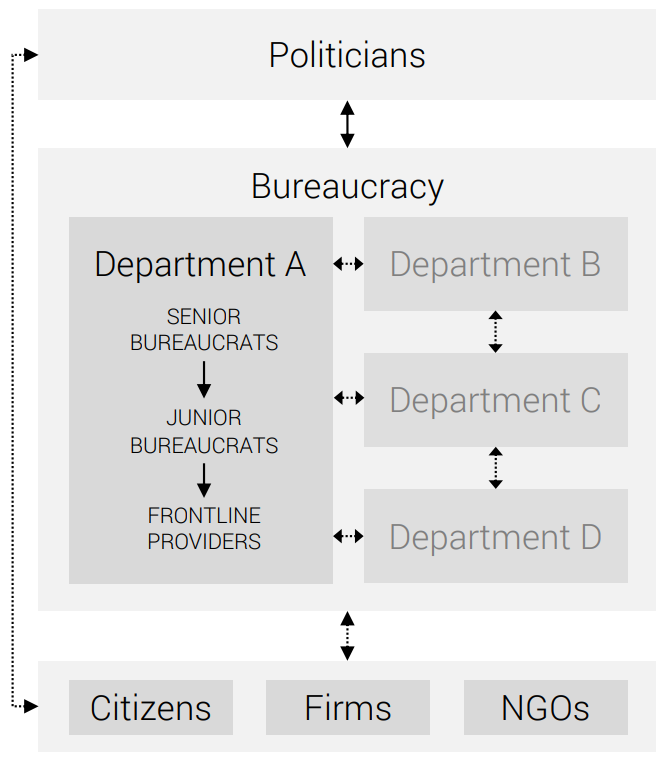
The rise of the institutions and state capacity paradigms in economics has brought bureaucratic effectiveness to the forefront of the debate on how to foster economic growth and development. While there is little disagreement that effective public administration is central to economic development, the debate around identifying the building blocks of an effective and competent bureaucracy continues. As a result there is a growing appetite for opening the black box of bureaucracies and understanding the formation, governing rules and continued transformation of effective bureaucracies.
This VoxDevLit explores this issue, taking stock of how far we understand the building blocks needed to strengthen the administrative capacity of the state. This is important, since a well-functioning state can play a role in encouraging growth and poverty reduction while preserving basic liberties and expanding access to public goods and services. We will review the emerging literature on bureaucracy and development while discussing where gaps in our knowledge remain. Figure 1 provides a diagrammatic representation of a bureaucracy embedded in the wider society, encapsulating much of what we cover in the paper. As Figure 1 makes clear, how well bureaucrats dispense their duties, and the degree to which bureaucratic systems serve the public interest and promote development, will depend on interactions (i) between different levels of bureaucracy, (ii) between government departments, (iii) between citizens, politicians and bureaucrats and (iv) between bureaucrats and firms and NGOs. Our review will be structured along these interactions.

The term “bureaucrat” refers to paid officials responsible for discharging the core functions of public administration. This includes those directly employed as part of the state apparatus as well as officials in quasi-independent public organisations such as central banks. Importantly, there is a clear distinction between such state employees selected by a superior and a politician picked in an election (Alesina and Tabellini 2007). The study of bureaucracy is often confined to senior-level bureaucrats but, given the expansion of the state to the delivery of core public services, it makes sense to include delivery professionals in healthcare, policing and education, often referred to as frontline providers who are also referred to as “street-level” bureaucrats. While the term bureaucracy is also frequently applied outside of the public sector to the administrative functions that support private business, our focus in this VoxDevLit is on support for the core functions of the state, i.e. those professionals in public employment who provide key inputs and decision making that can impact on the effective delivery of the functions of the state.
The performance of bureaucracy matters when it allows the state to be more or less effective in taxing, regulating, enforcing laws, organising and providing infrastructure, and delivering public goods and services to citizens, firms and other non-governmental organisations (NGOs). Contemporary theories of the political economy of development put state effectiveness at centre stage and have come to view the design of political institutions as a key element. This was argued forcibly, for example in Acemoglu and Robinson (2012) who emphasise constraints on power and elections leading to states that are more inclusive. Besley and Persson (2011) argue that one of the main reasons why inclusive political institutions matter is by building an environment conducive to investing in state capacities which enable the state to enforce laws, regulate economic activity and provide public goods. While institutional design and political accountability take centre stage in the political economy literature, the role of the bureaucracy has received limited attention as an independent dimension of state capacity. This may be partly related to the difficulty of measuring the performance of bureaucrats – while politicians have to contest elections, bureaucrats are often generalists with lifelong tenures who perform many different roles across their careers thus making it difficult to measure their performance (see Bertrand et al. 2020).
The remainder of the review is concerned with how modern economics is attempting to unpack the relationship between bureaucracy and development. Our first step is to focus on principal-agent relationships within the bureaucracy, as depicted by Department A in Figure 1. Contemporary studies of state effectiveness by economists have taken a granular approach trying to break down the problem of bureaucracy into its constituent parts. Tools such as randomised control trials have tried to isolate the efficacy of specific components such as the use of incentives or different strategies for recruiting state personnel (see Dal Bó et al. 2013, Finan et al. 2017). Viewed through this lens, many of the problems of poor governance can be understood as a failure to either incentivise bureaucrats or to select those who are most likely to do a good job. We therefore explore research on bureaucracies in economics through the lens of principal-agent problems, where a principal (a higher tier bureaucrat or politician) is trying to control the behaviour of an agent (a bureaucrat). Given the extensive economics literature on this, it constitutes a “safe space” for economists to apply their ideas and provides a powerful framework for exploring three related core elements that affect bureaucratic performance: incentives, selection, and measurement. For now, we are interested in the bilateral principal-agent relationships between senior and junior bureaucrats, as illustrated for Department A in Figure 1. We will also explore additional complexities that come from considering the importance of matching, multi-tasking and investing in expertise by both the principal and agent.
References
Acemoglu, D, and J A Robinson (2012), Why Nations Fail: The Origins of Power, Prosperity, and Poverty, Currency.
Alesina, A, and G Tabellini (2007), “Bureaucrats or Politicians? Part I: A Single Policy Task”, American Economic Review, 97(1): 169–179.
Besley, T, and T Persson (2011), Pillars of Prosperity: The Political Economics of Development Clusters, Princeton University Press.
Bertrand, M, R Burgess, A Chawla, and G Xu (2020), “The Glittering Prizes: Career Incentives and Bureaucrat Performance”, Review of Economic Studies, 87(2): 626–655.
Dal Bó, E, F Finan, and M A Rossi (2013), “Strengthening State Capabilities: The Role of Financial Incentives in the Call to Public Service”, Quarterly Journal of Economics, 128(3): 1169–1218.
Finan, F, B A Olken, and R Pande (2017), “The personnel economics of the developing state”, in Handbook of Economic Field Experiments, ed. by A V Banerjee and E Duflo, 2: 467–514, North-Holland.
Contact VoxDev
If you have questions, feedback, or would like more information about this article, please feel free to reach out to the VoxDev team. We’re here to help with any inquiries and to provide further insights on our research and content.

